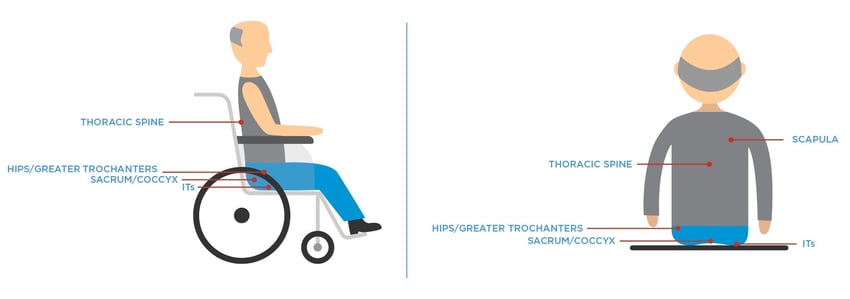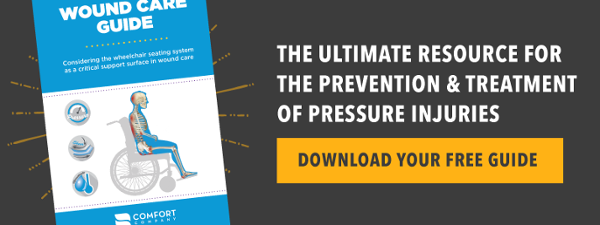Recall last week’s blog when we began our discussion on the factors that cause wounds. Extrinsic factors are what we as therapists can address in treatment and are caused by the environment, and/or seating surface. The extrinsic factors are:
- Prolonged Pressure
- Shear
- Microclimate & Moisture
This week, we focus on Prolonged Pressure and its attribution to wound development.
Prolonged pressure is the extrinsic factor that therapists are most familiar with since we usually blame pressure solely for most wound development. Although it does not function alone, it is a key instigator in the fight against wounds.
When we are sitting, 75% of our weight is going through our pelvis. So prolonged sitting, especially in abnormal postures, causes too much pressure on the bony prominences of the pelvis and places us at high risk for skin breakdown of the pelvis and/or hip bones.
To make a LTC therapist’s job even more interesting, the geriatric population is very susceptible to wound development at the peak pressure points due to:
- Limited mobility
- Multiple co-morbidities
- Impaired sensation
- Frail skin
- Skeletal changes
Prolonged Pressure can be defined as:
- Peak Pressures that are points under bony prominences that lead to areas of skin breakdown without the appropriate cushion or pressure relieving techniques.
- Peak Pressures cause skin breakdown at the ITs, sacrum, coccyx, trochanter and on the spinous process injuring the skin and underlying tissue, muscle, and in extreme cases, bone.
Here are two great diagrams to help you visualize the common areas of skin breakdown:

Now you understand:
- What prolonged pressure is
- Why our residents are threatened by it
- What areas of the body are red flags to be attacked by pressure
Tune in next week to see what to look for in a cushion to alleviate the negative effects of prolonged pressure!

Ana Endsjo, MOTR/L, CLT
Clinical Education Manager LTC Division
Ana Endsjo has worked as an occupational therapist since 2001 in a variety of treatment settings. She has mainly worked with the geriatric population, dedicated to the betterment of the treatment of the elderly in LTC centers. Her focus has been on seating and positioning and contracture management of the nursing home resident. With this experience, her hope is to guide other therapists, rehab directors, nurses, and administrators through educational guides, blogs, webinars, and live courses in her role as Clinical Education Manager for the long term care division.

